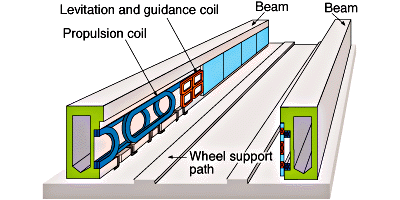Maglev Trains
Created by Rachel Steppe (rsteppe3)
Maglev trains are high-speed trains that use principles of electromagnetism as well as electromagnetic propulsion to run. The main difference between a Maglev train and a conventional train is that rather than using an engine to propel itself along the train track, a Maglev train is designed to run using a magnetic field created be electric coils within the guideway walls and track.

How Maglev Trains Work
Basic Physics Principles
Maglev trains use basic magnetic repulsion and attraction in order to levitate over the track. Both the train and the tracks produce a magnetic field and the different interactions of these fields can be used in different ways to induce levitation. There are two different types of Maglev trains but both employ the use of either an electromagnet or a strong permanent magnet. One formula that can be used to determine the magnetic field of one of the coils within the Maglev train system is the formula for a solenoid [math]\displaystyle{ B = {\mu _{0}} \frac{NI}{L} }[/math].

Types of Maglev Trains (Examples)
Electromagnetic Suspension (EMS) Trains
Electromagnetic Suspension (EMS) trains utilize electromagnets within the train to attract the train to the metal track. Because this type of Maglev train relies upon magnetic attraction, it has to be closely monitored electronically. Magnetic force is inversely related to the cubed distance of the two objects being considered. Essentially this means even a minor shift in the distance between the train and the track can result in a variation in magnetic force. This is why EMS trains must be monitored to maintain the typical 1/3 of an inch distance between the train and the track.
Electrodynamic Suspension (EDS) Trains
Electrodynamic Suspension (EDS) trains utilize superconducting electromagnets or permanent magnets to create a magnetic field which will then induce a current in nearby conductors to propel the train along the tracks. In this type of Maglev train the force in the track is created by an induced magnetic field within the wires on the track. This means that the magnetic fields will realign themselves without needing to be monitored. However, if the train is not moving fast enough to create a large enough magnetic flux, the train will not levitate. Also due to the nature of the induced magnetic field, there will be a magnetic drag force present on the train as well. This is only a problem though at low speeds. The Inductrack is a specific type of EDS that uses permanent room-temperature magnets to produce the magnetic fields. Typically the magnets used for EDS need to be super cooled which saves more energy. The newer material in Inductrack also creates stronger magnetic fields which leads to more extreme levitation.
Connectedness
1.How is this topic connected to something that you are interested in? Maglev trains are a major development in travel. As a person with great concern for the environment it is fascinating to see devices like this show up that can run without engines and basically without emissions. 2.How is it connected to your major? Mechanical Engineers have many different paths of study they can choose to follow, one of these involving machine design. Countless Mechanical Engineers spent their time developing and building Maglev trains as well as the tracks and guideways. 3.Is there an interesting industrial application? The application of Maglev trains is the actual train itself being used. This means that some applications of the train are its public transportation uses like in Shanghai or in some airports in New York.
History
Initial Development
Even though Maglev type of technology has been under development for decades it is only in recent years that it has actually become feasible.The first commercial Maglev train was developed by Transrapid International (a company based out of Germany) and made its test debut in Shanghai, China, in 2002. Transrapid International also made the first public/commercial run of the train in 2003.
Modern Implementation
Multiple countries are either using or working on developing commercial Maglev trains currently. However, the top two developers/competitors are Germany and Japan.
Japan's Version of Maglev
Japanese engineers worked on developing a Maglev train that uses electrodynamic suspension (EDS). These Japanese trains use super-cooled, superconducting electromagnets which are super magnets that can continue to conduct electricity even if the power supply gets cut off. This means that unlike the EMS system, electricity can be conducted without a power supply present. This cooling of the coils saves energy but the cryogenic system necessary for the cooling can be expensive. The Japanese model also requires rubber wheels that must be used until the train reaches its base sped. Levitation can only occur for EDS systems after the train is in motion and has reached a certain minimum speed (typically about 62 mph).
Germany's Version of Maglev
In Germany, engineers have developed Transrapid for their Maglev trains. Transrapid is a an electromagnetic suspension (EMS) system where the bottom of the train wraps around a steel guideway. Electromagnets attached to the train's undercarriage are directed up toward the guideway, which levitates the train above the guideway and keeps the train levitated constantly even when the train is at rest. The Transrapid Maglev train can reach 300 mph which is much faster than a conventional train as well as many of the earlier models of the Maglev trains.
See also
Further reading
Basics About Maglev Trains: http://science.howstuffworks.com/transport/engines-equipment/maglev-train.htm
News About Maglev Trains: http://www.21stcenturysciencetech.com/articles/Summer03/maglev2.html
External Links
Basics About Maglev Trains: http://science.howstuffworks.com/transport/engines-equipment/maglev-train.htm
News About Maglev Trains: http://www.21stcenturysciencetech.com/articles/Summer03/maglev2.html
News About Maglev Trains: http://www.wsj.com/articles/new-york-washington-maglev-train-gets-first-federal-funds-1446965516
References
http://science.howstuffworks.com/transport/engines-equipment/maglev-train.htm
http://www.eduplace.com/science/hmxs/ps/mode2/cricket/sect7cc.shtml
http://www.stuff.co.nz/travel/news/63558825/whats-the-worlds-fastest-passenger-train